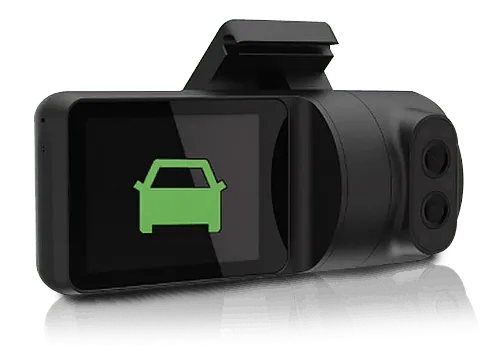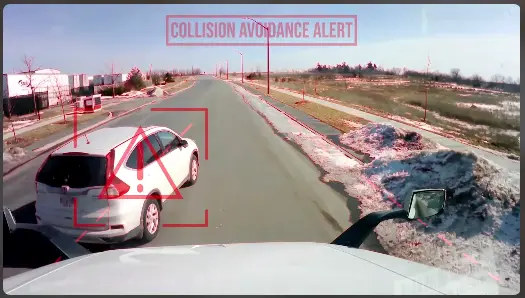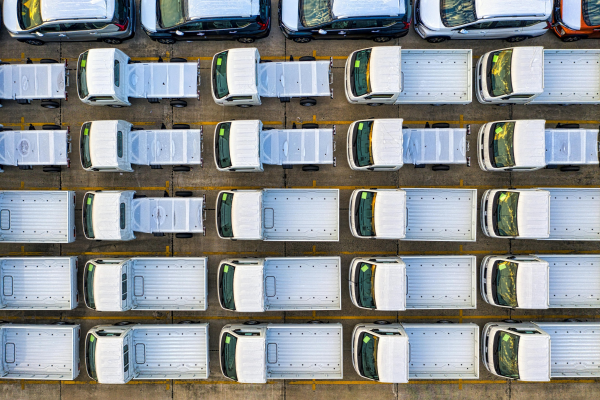Did you know that AI dash cams can reduce collisions by up to 60%? These innovative devices go beyond merely recording video. They analyze real-time data to identify potential dangers and alert drivers on the spot. More fleet managers and safety leaders notice significant boosts in driver performance and reductions in costs when they adopt AI dash cams. We’ll get into the main features, benefits, and uses of AI dash cam in this article. It will show why they are essential for today’s fleet management and road safety. Learn how AI dash cams can revolutionize your driving experience and improve how fleet managers promote safety in operations.
What is an AI Dash Cam?
An AI dash camera is a vehicle-installed camera that utilizes artificial intelligence to constantly monitor road conditions and, in the case of dual-facing models, driver behavior. These advanced cameras process real-time data to detect potential dangers and warn drivers, aiding in the reduction of distracted driving and the prevention of accidents.
By analyzing information either directly on the device or via the cloud, AI dash cam offers instant feedback and insights, proving to be an essential tool for improving driver safety, decreasing accidents, and cutting operational costs for fleet managers and safety leaders.
How does AI Powered Dash Cams work?
Data Collection
The camera consistently records video of the road in front, and for a dual-facing dash cam, it also monitors the rear camera and the driver’s actions, capturing comprehensive footage to assess driving conditions and behavior.
Real-Time Analysis
To identify and evaluate possible dangers, the AI dash cam analyzes the camera material in real-time using machine learning models. This includes speeding, hard braking, distracted driving, and other risky actions, It provides immediate feedback, enabling drivers to make quick adjustments. This proactive approach significantly enhances overall driving safety and performance, helping to prevent accidents and promote better driving habits.
Driver Alerts
When the AI identifies a dangerous situation, using AI technology it immediately alerts the driver with sound or visual signals. These notifications enable the driver to quickly correct their behavior, thus preventing accidents and encouraging safer driving habits.
Edge and Cloud Processing
The AI and AI dashcam can process data on the device itself (edge processing) for instant feedback or transmit it to the cloud for extensive analysis and storage, guaranteeing a thorough evaluation and improved long-term insights for driver safety.
Feedback to Fleet Managers
The processed data is subsequently sent to fleet managers, offering them comprehensive insights into driver performance, identifying safety concerns, and highlighting areas that require improvement. This information helps fleet managers implement targeted strategies to enhance overall driver safety and efficiency.
Event Recording
The dash camera marks and saves pertinent video footage if an incident occurs. This footage can be invaluable for reconstructing accidents, processing insurance claims, and providing driver training. It offers clear evidence and insights to improve future driving practices and safety.
What are the benefits of an AI Dash Cam

AI dash cams provide a range of benefits that improve driver safety and boost fleet management efficiency. Here are the main advantages:
Real-Time Hazard Detection
An AI dashcam constantly observes road conditions and driver behavior to provide instant alerts for potential hazards. This proactive approach to forward collision warning helps prevent accidents by prompting drivers to take immediate corrective actions.
Improved Driver Performance
By analyzing driving patterns and providing instant feedback, a fleet dash cam helps drivers refine their skills, coach drivers to curb risky behaviors such as distracted driving, and embrace safer driving habits.
Accident Reduction
Equipped with real-time alerts and behavior monitoring, fleet dash cameras can greatly decrease accident rates. They enhance driver awareness and safety by addressing risky behaviors promptly, ensuring better protection for both drivers and their vehicles.
Cost Savings
Fewer accidents translate to reduced repair and maintenance expenses, lower insurance premiums, and decreased liability claims. Fleet dash cams promote efficient driving habits, optimizing fuel consumption and further reducing operational costs for drivers and fleet managers.
Enhanced Fleet Management
Fleet managers receive comprehensive reports on driver behavior, vehicle performance, and safety concerns, providing valuable insights. This detailed data enables more strategic decision-making and targeted interventions, ultimately enhancing fleet operations, improving driver performance, and increasing overall safety and efficiency across the whole fleet management platform.
Evidence Collection
AI dash cams offer tagged video footage in accidents, facilitating accurate reconstruction, insurance claims, and legal disputes. This clear evidence ensures fair outcomes by providing a reliable account of events, aiding in the resolution of complex situations swiftly and justly.
Driver Training
Recorded dash cam footage and data analytics serve as training tools, pinpointing areas for driver improvement and reinforcing safe practices. This approach leads to a more skilled and reliable workforce, enhancing overall safety image quality, and efficiency within the fleet.
Compliance and Accountability
AI dash cams ensure adherence to safety regulations and company policies, promoting accountability through transparent, unbiased driving records. This comprehensive monitoring system fosters a culture of responsibility and compliance within the fleet, enhancing overall safety and operational integrity.
Customer Satisfaction
Fleet dash cams enhance punctuality and reliability by optimizing routes and minimizing accident-related downtime which is beneficial to businesses dependent on timely deliveries. This improvement boosts operational efficiency and increases customer satisfaction through consistently timely service.
Why fleet and safety leaders are using AI Dash Cams

Fleet managers and fleet safety leaders recognize that their drivers are their most valuable asset, with their primary aim being to ensure drivers are safe, successful, and appreciated. They also understand the importance of maintaining vehicle and driver productivity, minimizing collisions, and lowering liability and maintenance expenses.
Balancing these priorities can be challenging, leading many to adopt AI fleet dash cam solutions. These advanced systems help reduce accidents and related costs while enhancing driver safety. By providing real-time feedback, monitoring unsafe driving behavior often, and offering detailed reports, AI dash cams support fleet managers in making data-driven decisions. This technology not only safeguards drivers but also optimizes fleet operations, ensuring both efficiency and cost-effectiveness.
All AI dash cams are NOT created equal
Fleet safety technology companies increasingly claim to incorporate artificial intelligence (AI), deep learning, computer vision, and machine learning in their products. There can be confusion since these terms are used a lot. There are many ways to implement AI, including end-to-end from the edge to the cloud, at the network edge (within the car), and in the cloud. Let’s clarify these different AI models and explore their capabilities.
On the network edge (in-vehicle) AI processing
AI can reliably interpret driver behavior, traffic conditions, vehicle movement, and essential contextual data within driving environments. Its effectiveness hinges on successful in-vehicle deployment to assist drivers when it matters most. By executing AI-powered algorithms on a device, fleets can monitor driver behavior, and unsafe driving events, and instantly identify distracted driving and other high-risk activities. These real-time algorithms enable immediate coaching through progressive alerts, helping drivers refocus on the road promptly.
In the cloud AI processing
Most current video telematics and fleet dash cam solutions necessitate uploading driver video to the cloud for human analysis before identifying distractions. This approach has significant drawbacks due to the latency involved in transmitting data to and from the cloud, delaying real-time alerts. Drivers miss the opportunity to take timely action to prevent incidents. Supervisors are often informed of issues before drivers are, as many systems do not notify drivers that data has been captured.
Edge-to-cloud implementation
While edge AI processing is designed for real-time collision avoidance, cloud-native software supports rapid model improvement, offering benefits like high availability, scalability, and reliability. The Traxxis GPS ZenduCAM solution securely stores and processes millions of data points from over a billion AI-analyzed video miles, optimizing driver performance.
ZenduCAM tests and refines all new and existing convolutional neural network (CNN) model inputs and outputs to achieve high accuracy in real-time footage of the cloud. These refined models are then deployed over the air to influence driver behavior in real-time, directly at the edge.
Final Thoughts
AI dash cams are transforming road safety and fleet management by utilizing advanced artificial intelligence to observe driving conditions and driver behavior in real time. These cutting-edge devices capture high-definition video and offer instant alerts for potential dangers, greatly reducing accident risks. Fleet managers and fleet safety leaders can apply targeted enhancements and cost-cutting measures because they obtain important insights regarding driver performance.
A fleet dash cam can track driving trends and offer in-the-moment feedback. It can assist drivers in honing their craft, forming safer driving habits, and cutting down on risky behaviors like distracted driving. The information gathered and analyzed by these intelligent cameras is essential for driver training, insurance claims, and accident reconstruction to promote a safer and more effective fleet operation.





